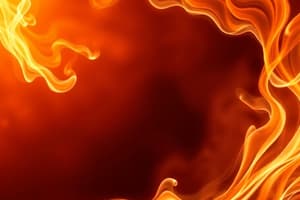Podcast
Questions and Answers
Match the following types of energy with their definitions:
Match the following types of energy with their definitions:
Kinetic Energy = Energy an object possesses due to its motion Thermal Energy = Energy that flows between objects due to temperature differences Chemical Energy = Energy stored in the bonds of chemical compounds Potential Energy = Energy stored in an object due to its position or state
Match the following examples with the corresponding type of energy:
Match the following examples with the corresponding type of energy:
Moving water = Kinetic Energy Heating a metal rod = Thermal Energy Gasoline in a car's fuel tank = Chemical Energy A stretched rubber band = Potential Energy
Match the following formulas with the type of energy they calculate:
Match the following formulas with the type of energy they calculate:
KE = 0.5 * m * v² = Kinetic Energy Q = mcΔT = Thermal Energy E = mc² = Chemical Energy PE = mgh = Potential Energy
Match the following applications with the type of energy they primarily deal with:
Match the following applications with the type of energy they primarily deal with:
Match the following descriptions with the correct type of energy:
Match the following descriptions with the correct type of energy:
Match the following examples with the correct type of energy:
Match the following examples with the correct type of energy:
Match the following conversions with the correct type of energy:
Match the following conversions with the correct type of energy:
Match the following forms with the correct type of potential energy:
Match the following forms with the correct type of potential energy:
Match the following industries/applications with the primary type of energy they utilize:
Match the following industries/applications with the primary type of energy they utilize:
Match the following daily life scenarios with the corresponding type of energy involved:
Match the following daily life scenarios with the corresponding type of energy involved:
Study Notes
Exploring Forms of Energy: Kinetic, Thermal, Chemical, and Potential
Energy is a fundamental concept in the natural world, and it comes in various forms that underpin our daily lives and power modern society. In this article, we'll dive into the four primary forms of energy: kinetic, thermal, chemical, and potential, exploring their definitions, examples, and applications.
Kinetic Energy
Kinetic energy is the energy an object possesses due to its motion. It is the energy an object has as it moves, determined by its mass and velocity. For example, when you throw a ball, it has kinetic energy as it moves through the air. Kinetic energy is also present in moving water, wind, and even subatomic particles.
Kinetic energy can be calculated using the formula:
KE = 0.5 * m * v²
where KE is the kinetic energy, m represents mass, and v is velocity.
Kinetic energy plays a significant role in various applications, including sports, engineering, and transportation. For instance, the wind turbines in wind farms harness the kinetic energy of wind to generate electricity.
Thermal Energy
Thermal energy, also known as heat energy, is the energy that flows between objects as a result of their temperature differences. When an object is heated, its thermal energy increases, while a cooler object absorbs this energy, causing its temperature to rise.
Thermal energy is measured in Joules, a unit of energy. In thermodynamics, thermal energy can be transferred between systems in three ways: conduction, convection, and radiation.
Thermal energy is essential in daily life and various industries. For example, heating and cooling systems in homes and offices use thermal energy to maintain comfortable temperatures. Thermal energy is also a critical component of industrial processes like metalworking and food production.
Chemical Energy
Chemical energy is the energy stored within the bonds of chemical substances, such as fuels and batteries. When these substances undergo a chemical reaction, the chemical energy is released, producing thermal, kinetic, or electrical energy.
Chemical energy is crucial in our daily lives, as it powers engines, appliances, and even our bodies. When we eat food, our bodies break down the energy stored in the chemical bonds of the food molecules to release energy for use in various biological processes.
Potential Energy
Potential energy is the energy an object possesses due to its position or configuration. This energy can be converted into kinetic or thermal energy when the object moves or changes its configuration.
For example, a ball resting at the top of a hill has potential energy due to its height above the ground. When the ball is released, its potential energy is converted into kinetic energy, causing it to roll down the hill.
Potential energy is also present in other forms, such as gravitational potential energy, elastic potential energy, and electrical potential energy. These forms of potential energy are significant in various applications like building structures and powering electronics.
In conclusion, the four primary forms of energy—kinetic, thermal, chemical, and potential—are integral to our daily lives and industries. Understanding these forms of energy and their interactions helps us develop innovative solutions for various applications, from wind turbines to smartphones.
Studying That Suits You
Use AI to generate personalized quizzes and flashcards to suit your learning preferences.
Description
Test your understanding of the four primary forms of energy: kinetic, thermal, chemical, and potential with this quiz. Explore the definitions, examples, and applications of each form to deepen your knowledge of energy concepts.




